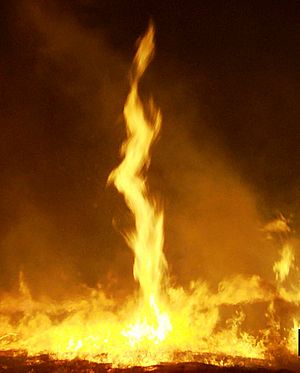Fire whirl facts for kids
Quick facts for kids Fire whirl |
|
|---|---|

A fire whirl with flames in the vortex
|
|
| Area of occurrence | Worldwide (most frequent in areas subject to wildfires) |
| Season | All year (most frequent in dry season) |
| Effect | Wind damage, burning, propagation/intensification of fires |
A fire whirl (also called a fire devil or fire tornado) is like a spinning column of air, but it's caused by a fire. It often contains flames or ash. It starts when strong heat from a fire mixes with windy conditions. This creates spinning air currents, called eddies. These eddies can form a tornado-like vortex that pulls in burning stuff and hot gases.
People sometimes call them "fire tornadoes" or "firenados." However, these names usually mean a different event. A true fire tornado is when a fire is so big it creates an actual tornado. Most fire whirls are not real tornadoes. This is because their spinning air doesn't reach from the ground all the way up to the clouds. Also, their spin comes from winds near the ground and heat, not from a storm system high up.
The first time a fire whirl was officially confirmed was during the 2003 Canberra bushfires in Australia. Since then, they have been seen in the 2018 Carr Fire and 2020 Loyalton Fire in California.
Contents
How Fire Whirls Form and Grow
A fire whirl has a burning center and a spinning pocket of air around it. These whirls can get super hot, reaching temperatures of about 2,000 °F (1,090 °C). Fire whirls happen often when a wildfire or a huge firestorm creates its own strong winds. These winds can then make large spinning columns. Even small bonfires can have tiny whirls, and scientists have made them in labs.
Where Do They Appear?
Most of the biggest fire whirls come from large wildfires. They form when there's a warm updraft (air moving upwards) and winds coming together from the fire. They are usually 10–50 m (33–164 ft) tall and a few meters wide. Most only last for a few minutes. But some can be over 1 km (0.6 mi) tall. They can have wind speeds over 200 km/h (120 mph) and last for more than 20 minutes.
What Damage Can They Cause?
Fire whirls are very powerful. They can even pull up trees that are 15 m (49 ft) tall or more. They also help wildfires spread. They do this by lifting burning materials, like tree bark. These burning pieces can then be carried far away by stronger winds, starting new fires.
Fire whirls can also be common near the smoke plume during a volcanic eruption. These can be small or large. They form in different ways, similar to how regular fire whirls form. Sometimes, they can even lead to Cumulonimbus flammagenitus (cloud) clouds. These clouds can create landspouts and waterspouts, which are like small tornadoes.
Different Kinds of Fire Whirls
Scientists have identified a few main types of fire whirls:
- Type 1: These are stable and stay right over the burning area.
- Type 2: These can be stable or move around. They are usually downwind (in the direction the wind is blowing) from the burning area.
- Type 3: These can be steady or move around. They are centered over an open area next to a burning area that is not perfectly round, with wind blowing.
There's a belief that a fire whirl during the 1923 Great Kantō earthquake was a Type 3. Other ways fire whirls can form might exist too. A scientist named Forman A. Williams suggested a broader way to group fire whirls into five categories:
- Whirls made by how fuel is spread out in the wind.
- Whirls above fires in pools or on water.
- Tilted fire whirls (leaning over).
- Moving fire whirls.
- Whirls changed by something called "vortex breakdown."
Weather experts see some fire-caused events as atmospheric events. For example, fire-induced clouds are called pyrocumulus and pyrocumulonimbus. Larger fire whirls are also being looked at this way. Based on how big the spinning air is, new terms like pyronado, "pyrotornado", and "pyromesocyclone" have been suggested.
Blue Whirls
In small experiments, scientists have seen fire whirls change into something called "blue whirls." They are called "blue whirls" because they produce very little soot. This means they don't have the usual yellow color of a fire whirl. Blue whirls are special flames that stay floating in a certain part of the spinning air. They are shorter and burn slower than regular fire whirls.
See also
 In Spanish: Remolino de fuego para niños
In Spanish: Remolino de fuego para niños

